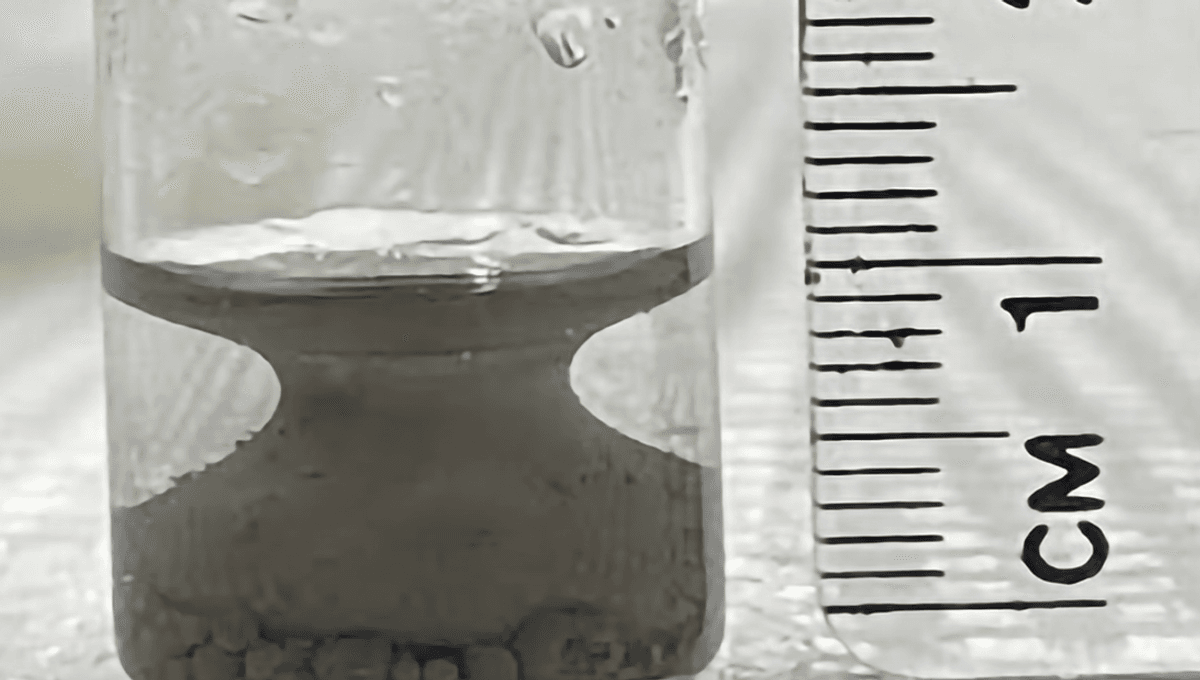
A student playing around with fluids and magnetic materials in the lab may have accidentally found an “exception” to the laws of thermodynamics, according to the authors of a new paper based on his work. The result is a strange “shape-recovering liquid” that forms a Grecian urn shape no matter how much it is shaken.
Certain liquids do not want to play together: for an easy example, oil and water. If you put these two classic liquids together and try to mix them, the less dense oil will float on top. This is a result of the bonds within the two fluids.
In water (H20), the oxygen end of the molecule has a partial negative charge, and the hydrogen end has a partial positive charge. The result is molecules that attract each other loosely, forming (at the right temperatures) our favorite liquid. Oils meanwhile, do not have these charged polar ends. The result is that the oils are not attracted to water, and do not want to mix with it, as to do so they would have to break some of the water’s hydrogen bonds.
However, it is possible to make oil and water mix by using a surfactant.
“When a detergent molecule contacts a nonpolar compound such as oil, it slides its nonpolar end between the nonpolar molecules of the oil,” Exploring Our Fluid Earth from the University of Hawai’i explains. “While its nonpolar end is attracted to the oil, its charged end faces outward and attracts water molecules. When many detergent molecules attach to a nonpolar oil droplet, they surround it and make a detergent-surrounded oil droplet. These droplets are then easily carried into the water solution.”
Of course, it’s not just soaps that are surfactants. In mayonnaise, for instance, the surfactant is lecithin from the egg yolk.
“Imagine your favorite Italian salad dressing,” Thomas Russell, Silvio O. Conte Distinguished Professor of Polymer Science and Engineering at UMass Amherst and one of the new paper’s senior authors, explained in a statement. “It’s made up of oil, water and spices, and before you pour it onto your salad, you shake it up so that all the ingredients mix.”
In this example, the surfactants are the spices, which allow the two substances to temporarily mix. The process is known as emulsification, and is well described by the laws of thermodynamics.
Here’s where it gets interesting. UMass Amherst graduate student Anthony Raykh was playing around with different non-mixing liquids. During this, he chose to use magnetized particles of nickel “because you can engineer all sorts of interesting materials with useful properties when a fluid contains magnetic particles,” according to Raykh. He then shook the liquids furiously “and, in a complete surprise, the mixture formed this beautiful, pristine urn-shape.”
No matter how much Raykh shook the mixture, the liquids would always return to this weird structure.
“I thought ‘what is this thing?’ So, I walked up and down the halls of the Polymer Science and Engineering Department, knocking on my professors’ doors, asking them if they knew what was going on,” Raykh explained.
None of the professors knew what was going on either, but two professors took an interest and contacted colleagues at Tufts and Syracuse universities to create simulations.
“When you see something that shouldn’t be possible, you have to investigate,” Russell said.
In short, why it was so interesting is that the surfactant should have allowed the two liquids to mix. In accordance with the laws of thermodynamics (which we obey in this house) the liquid should be a mixture, rather than what appears to be an hourglass figure in its lowest energy state.
Looking closely at the interactions, the team found that the magnetized nickel actually increased the tension between the two liquids, rather than decrease it as is usual.
“When you look very closely at the individual nanoparticles of magnetized nickel that form the boundary between the water and oil,” David Hoagland, professor of polymer science and engineering at UMass Amherst, explained, “you can get extremely detailed information on how different forms assemble. In this case, the particles are magnetized strongly enough that their assembly interferes with the process of emulsification, which the laws of thermodynamics describe.”
According to the team, the strange shape it makes is set by the vessel itself.
“Rather than promoting emulsification, interfacially active magnetic particles serve to eliminate emulsification entirely due to long-lived heterogeneities imposed on the liquid interfaces by in-plane magnetic particle interactions. The energies of these interactions are large, attractive and directional (dependent on the interparticle orientation), so the stabilization occurred concurrently with an increase in the interfacial tension,” the team explains in their paper.
“The dipolar anisotropy in magnetic interactions creates a string-like particle surface network with openings large enough to enable facile liquid transfer between contacting droplets. The particles thereby bolster the equilibration and re-equilibration of structured liquid interfaces, as evidenced by the urn-shaped phase that formed in a cylindrical vessel. Only the wetting conditions of the liquid surface and the vessel walls affected the shape.”
The finding currently does not have any applications, though Raykh is hopeful that the never-before-seen state could be investigated and further soft-matter physics.
The study is published in Nature Physics.
Source Link: "Shape-Recovering Liquid" May Be An "Exception" To The Laws Of Thermodynamics